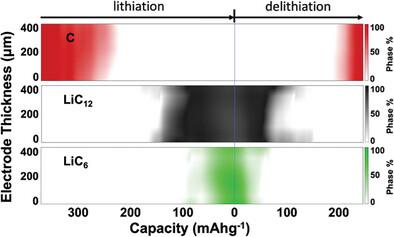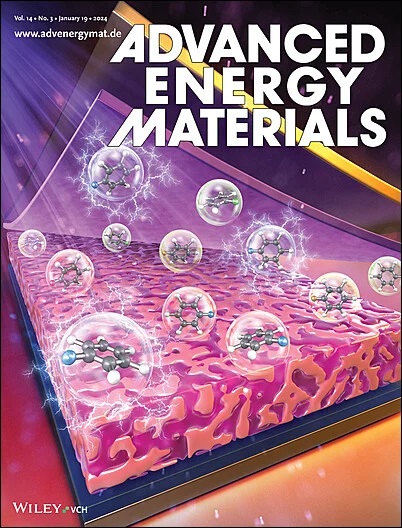Concurrent Operando Neutron Imaging and Diffraction Analysis Revealing Spatial Lithiation Phase Evolution in an Ultra-Thick Graphite Electrode
IF 24.4
1区 材料科学
Q1 CHEMISTRY, PHYSICAL
引用次数: 0
Abstract
Energy-efficient, safe, and reliable Li-ion batteries (LIBs) are required for a wide range of applications. The introduction of ultra-thick graphite anodes, desired for high energy densities, meets limitations in internal electrode transport properties, leading to detrimental consequences. Yet, there is a lack of experimental tools capable of providing a complete view of local processes. Here, a multi-modal operando measurement approach is introduced, enabling quantitative spatio-temporal observations of Li concentrations and intercalation phases in ultra-thick graphite electrodes. Neutron imaging and diffraction concurrently provide correlated multiscale information from the scale of the cell down to the crystallographic scale. In particular, the evolving formation of the solid electrolyte interphase (SEI), observation of gradients in total lithium content, as well as in the formation of ordered LixC6 phases and trapped lithium are mapped throughout the first charge–discharge cycle of the cell. Different lithiation stages co-exist during charging and discharging; delayed lithiation and delithiation processes are observed in central regions of the electrode, while the SEI formation, potential plating, and dead lithium are predominantly found closer to the interface with the separator. The study emphasizes the potential to investigate Li-ion diffusion and the kinetics of lithiation phase formation in thick electrodes.

同时操作中子成像和衍射分析揭示了超厚石墨电极的空间锂化相演化
节能、安全、可靠的锂离子电池(LIBs)是广泛应用的需要。超厚石墨阳极的引入,需要高能量密度,满足内部电极传输特性的限制,导致有害的后果。然而,缺乏能够提供本地过程完整视图的实验工具。本文介绍了一种多模态operando测量方法,可以对超厚石墨电极中的锂浓度和插层相进行定量的时空观测。中子成像和衍射同时提供了从细胞尺度到晶体尺度的相关多尺度信息。特别是,在电池的第一次充放电循环中,固体电解质间相(SEI)的演变形成,总锂含量的梯度观察,以及有序LixC6相和捕获锂的形成都被绘制出来。充放电过程中不同的锂化阶段并存;在电极的中心区域观察到延迟的锂化和去锂化过程,而SEI形成、电位镀和死锂主要在靠近隔板的界面处发现。该研究强调了在厚电极中研究锂离子扩散和锂化相形成动力学的潜力。
本文章由计算机程序翻译,如有差异,请以英文原文为准。
求助全文
约1分钟内获得全文
求助全文
来源期刊

Advanced Energy Materials
CHEMISTRY, PHYSICAL-ENERGY & FUELS
CiteScore
41.90
自引率
4.00%
发文量
889
审稿时长
1.4 months
期刊介绍:
Established in 2011, Advanced Energy Materials is an international, interdisciplinary, English-language journal that focuses on materials used in energy harvesting, conversion, and storage. It is regarded as a top-quality journal alongside Advanced Materials, Advanced Functional Materials, and Small.
With a 2022 Impact Factor of 27.8, Advanced Energy Materials is considered a prime source for the best energy-related research. The journal covers a wide range of topics in energy-related research, including organic and inorganic photovoltaics, batteries and supercapacitors, fuel cells, hydrogen generation and storage, thermoelectrics, water splitting and photocatalysis, solar fuels and thermosolar power, magnetocalorics, and piezoelectronics.
The readership of Advanced Energy Materials includes materials scientists, chemists, physicists, and engineers in both academia and industry. The journal is indexed in various databases and collections, such as Advanced Technologies & Aerospace Database, FIZ Karlsruhe, INSPEC (IET), Science Citation Index Expanded, Technology Collection, and Web of Science, among others.
 求助内容:
求助内容: 应助结果提醒方式:
应助结果提醒方式:


